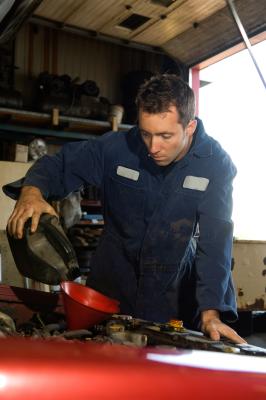
A torque converter acts in an automatic transmission the way a clutch would in a manual transmission. Using high pressure fluid to couple the engine and transmission, the torque converter requires clean fluid to operate correctly. Small particles and debris from deterioration in the automatic transmission can prevent the torque converter from being fully efficient and may cause damage. Flushing the debris requires an exchange of transmission fluid. Mechanical dis-assembly of the torque converter is required when particles are too large to be suspended and removed through fluid exchange.
Park the vehicle on a level surface. Engage the parking brake. Open the hood. Allow the transmission to cool for 30 minutes if the engine is hot.
Determine the exact transmission fluid capacity of your transmission. The total transmission capacity will include the fluid contained in the torque converter. The information will be available in the vehicle's owner's manual. Buy or acquire enough fluid to replace the total capacity, plus an additional two quarts.
Position a bucket or catch pan under the transmission cooling line. The transmission cooling line will connect either to the radiator -- in dual core radiators -- or to a separate smaller radiator.
Disconnect the transmission cooling line. Direct the fluid flow into the bucket or catch pan. Secure the line to the catch pan, or have an assistant help.
Pull the dipstick from the automatic transmission fluid check tube.
Start the vehicle. Immediately place the transmission gearing in the "Neutral" position. Fluid will be expelled from the transmission cooling line at this time. Check to ensure the fluid is still draining into the catch pan.
Place a funnel at the mouth of the transmission dipstick tube. Pour in transmission fluid at about the same rate fluid is being drained into the catch pan.
Move the transmission through each of the gears when about three quarters of the total fluid capacity of the transmission has been drained and replaced. You will need an assistant to continue filling the transmission during this process. Once the transmission has move through all the gears, including "Reverse," move the transmission back to the "Neutral" position.
Turn off the engine, once the full amount of transmission fluid has been exchanged, turn off the engine.
Reconnect the transmission cooling line. Restart the engine.
Use the dipstick to check the level of fluid in the transmission. Add fluid as necessary. Drive the vehicle for approximately 5 miles. Recheck the fluid level.